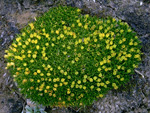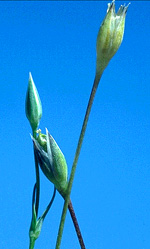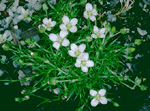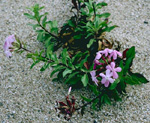 |
A large, cosmopolitan family, Caryophyllaceae are particularly characteristic of temperate and cold regions, with few species occurring in the tropics. In Australia, many species are introduced, minor weeds of disturbed places. Some species are native, found from the deserts to the alps; except for Drymaria and Polycarpaea the family is virtually absent from northern Australia.
Characteristic features of the family Caryophyllaceae in Australia include: - annual or perennial herbs, rarely herbaceous scrambling vines
- leaves simple, opposite (rarely alternate), often with thin, dry interpetiolar stipules
- petals free, often toothed or deeply divided, sometimes absent
- stamens usually 5 or 10
- ovary usually 1-celled, with the ovules basal or borne on a free, central placenta
- fruit dry, usually a capsule opening by terminal valves or teeth
Description
Annual or perennial terrestrial herbs or rarely herbaceous scrambling vines. Perennating by rhizomes, taproots or crowns. Vegetative reproduction absent or by rhizomes or stolons. Stem nodes conspicuously swollen or not, internodes terete or angular. Internal secretions not obvious. Plants glabrous or with simple, glandular or non-glandular, unicellular or uniseriate hairs. Leaves opposite or rarely alternate and spiral, cauline or both basal and cauline, petiolate, subsessile or sessile. Stipules absent or present, distinct and free from the petiole, ochreate or interpetiolar, scale-like or membranous or lacerate or fimbriate, persistent. Lamina simple, symmetric, filiform, acicular, subulate, linear, lanceolate, ovate, elliptic, oblanceolate, ovate, oblong, orbicular or reniform; base cuneate, attenuate, rounded or cordate; margins entire, ±flat; one-veined, or the venation pinnate, parallel or obscure, with the midrib conspicuous or inconspicuous, and the tertiary venation not reticulate; surfaces not punctate; herbaceous or succulent. Male and female flowers occurring on separate plants, or with all the flowers bisexual. Inflorescences terminal or axillary, consisting of capitula, spikes, racemes, umbels, corymbs, dichasial or monochasial cymes or solitary flowers. Bracts present. Bracteoles present or absent. Pollination by insects. Flowers odourless or fragrant; sessile or stalked. Floral disc present (but sometimes obscure); nectaries present on the disc or stamens. Perianth regular, of 2 dissimilar whorls or of 1 whorl only or all whorls ±similar, imbricate in bud. Calyx segments free or fused, with 4–5 sepals or lobes; calyx cup-shaped, bell-shaped, urn-shaped or tubular, herbaceous or rarely papery. Corolla segments free, with 4–5 petals, alternating with the sepals or calyx lobes; corolla white, cream, yellow, red, pink, magenta, purple or violet, without contrasting markings, or streaked, spotted, etc, membranous; claws present or absent; lobes ±entire or notched, emarginate, bifid or bilobed. Fertile stamens 2–10, opposite to, or rarely alternating with, or both opposite to and alternating with, or not clearly correlated with, the sepals or calyx lobes, free or at least partly fused to the corolla, free of the ovary and style, distinct from each other, all ±equal. Staminodes present or absent. Anthers dorsifixed, versatile or not versatile, opening outwards or inwards by longitudinal slits; 2-celled. Ovary superior and sessile or rarely stalked (vestigial in male plants). Carpels 2–5, fused; ovary with 1 locule or partially 3–5-locular. Style terminal, single and branched above or from the base, or absent and the stigma ±sessile on the ovary. Ovules 1–numerous per locule, ?stalked or sessile; placentation partially axile (if 3–5 locules), basal or free-central (if 1 locule). Fruit dry, dehiscent or indehiscent, a denticidal capsule, or achene or nutlet; the perianth on the maturing fruit deciduous or dry and persistent. Disseminule macro-surface featureless or winged; micro-surface ±smooth, tuberculate, colliculate or papillate, orange, brown, grey or black, glossy or dull. Seeds 1–numerous per fruit. Aril absent. Cotyledons 2. Embryo straight, curved or coiled.
(Note: this description has been generated from the coded data compiled for the key. Any errors in the key data will be reflected in the descriptions.)
A treatment of the family Caryophyllaceae has not yet been published in
the Flora of Australia. It will appear in Volume 5.
Australian genera of Caryophyllaceae (as recognised for the Flora of Australia)
† = some species native, others introduced
* = all species introduced
*Agrostemma
*Arenaria
*Cerastium
Colobanthus
*Corrigiola
*Dianthus
Drymaria
*Gypsophila
*Herniaria
*Lychnis
*Minuartia
*Moenchia
*Paronychia
*Petrorhagia
Polycarpaea
*Polycarpon
Sagina
*Saponaria
†Scleranthus
*Silene
*Spergula
†Spergularia
†Stellaria
*Vaccaria

|
  |

Colobanthus nivicola (flowering plant)
Photo: C.Totterdell © ANBG

Moenchia erecta (flowers and young fruit)
Photo: J.Hosking © J.Hosking

Sagina diemensis (flowering plant)
Photo: R.Hotchkiss © ANBG

Saponaria officinalis (flowering plant)
Photo: M.Fagg © ANBG

|
 |
|